Isimba dam launched today
Banking on Isimba and Karuma, the President has on many occasion assured investors and the business community that the high electricity tariffs will soon go down.
ELECTRICITY ISIMBA DAM MUSEVENI
Isimba power will be cheapest in East Africa
Over the last five years, hundreds of workers have been crushing rocks, laying concrete and embankments across Africa's longest river, the Nile.
It is at this site that the Isimba Hydropower Dam, the third largest electricity plant and one of the country's biggest projects, has been taking shape.
On Thursday, President Yoweri Museveni will commission the plant, one of the most important hydropower projects that the Ugandan Government has embarked on, to ease power shortages in the country and accelerate the development of the local economy.
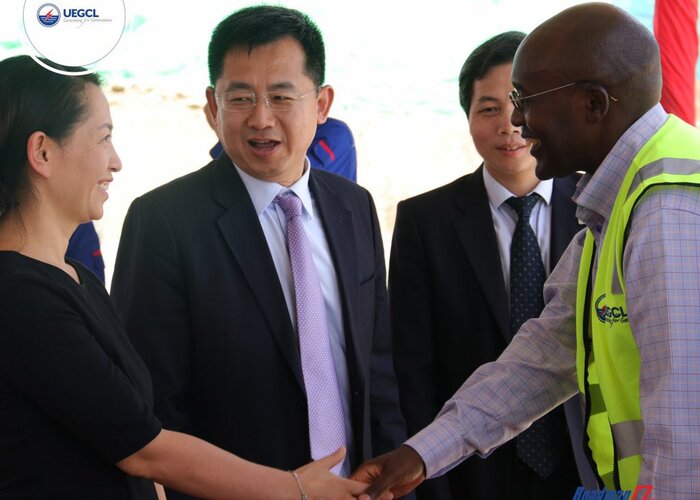
Guests at the function
The 183MW Isimba Hydropower project is 4km downstream of Isimba Falls on the River Nile and about 50km downstream from the source of the Nile. The project site is about 21km from Kayunga, the nearest town and about 65km from Jinja town.
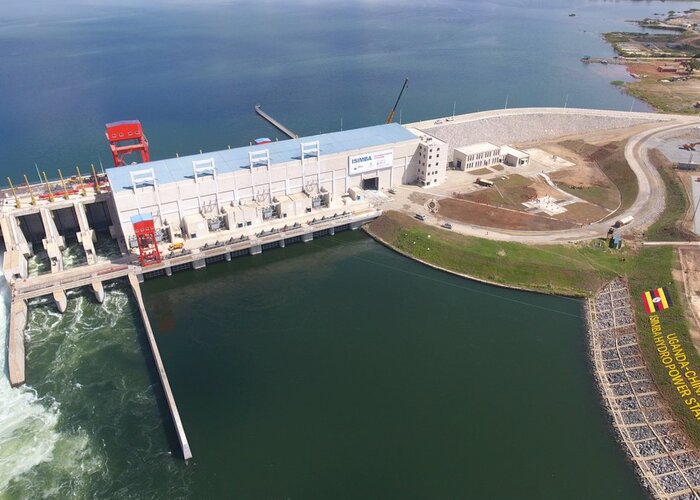
The dam
Isimba is expected to generate hydroelectric power at 68 cents per kilowatt, the lowest in East Africa. Main features Isimba dam, which cost $568m (about sh2.1 trillion), was fi nanced by a loan from China Export-Import Bank (85% funding), while the Uganda government contributed 15%.
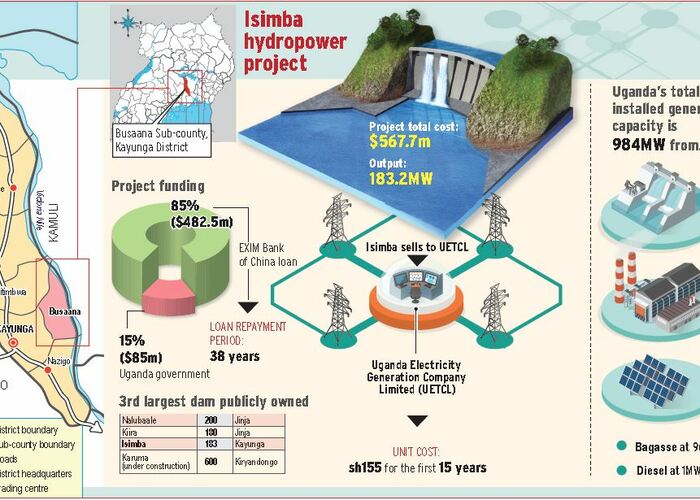
Graphics of the project
The project is located on the Victoria Nile, downstream of the 250MW Bujagali Falls hydropower plant. It extends over about 2,867.6 acres of land and comprises a concrete gravity dam, a clay-core rock fill dam, a spillway, a power house, electro-mechanical equipment, switching stations and auxiliary power transmission works.
The concrete dam, located on the left side, consists of a reservoir retaining structure in front of the erection bay, while the rock fill type with the central clay core right dam provides storage for emergency gates and stop logs. The powerhouse structure features four 45.8MW Kaplan turbines in the left dam. The external switchyard is situated on the left bank of the river and is connected with the powerhouse by four overhead lines.
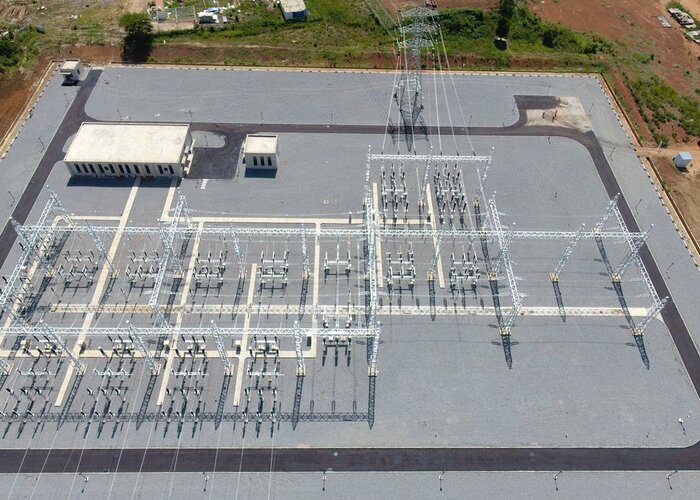
The station connecting to the transmission lines
The dam is a double busbar type with two line bays, four transformer bays, one bus coupler and two future bays. The generated power will be transmitted to the sub-station at Bujagali hydropower station through a 132kV Isimba-Bujagali double circuit transmission line. The 42km line has a 30m way leave, with a 5m right of way.
In addition to the construction of the dam and the double circuit transmission line, the project also includes the construction of a 33kV power line from Kayunga town to the project site, on Busana Road.
Contractors The Uganda Electricity Generation Company (UETCL) was appointed as the project implementing agency on behalf of the Government of Uganda.
China International Water and Electric Corporation (CWE) was awarded the engineering, procurement and construction contract for the project. The contract, signed between CWE and the Ministry of Energy and Mineral Development of Uganda in 2013, includes the construction of the power plant and the Isimba-Bujagali 132kV interconnection line.

CWE engaged Geotech Solutions to conduct site supplementary geological investigation, drilling and rock grouting works. Energy Infratech was engaged as the supervision consultant for the project and later in 2018, Artelia Eau and KKATT Consult Limited, a Ugandan fi rm, were hired by UEGCL after Energy Infratech's contract expired in 2017.
Importance of Isimba dam Amid low electricity demand with about 78% of the population still not connected to the national power grid, the Isimba hydropower plant is expected to boost the electricity generation with 183MW, pushing the country's electricity generation to 1,158MW. In January, President Yoweri Museveni launched the 20MW Kabulasoke Solar Power Plant pushing electricity generation from 955MW to 975MW.
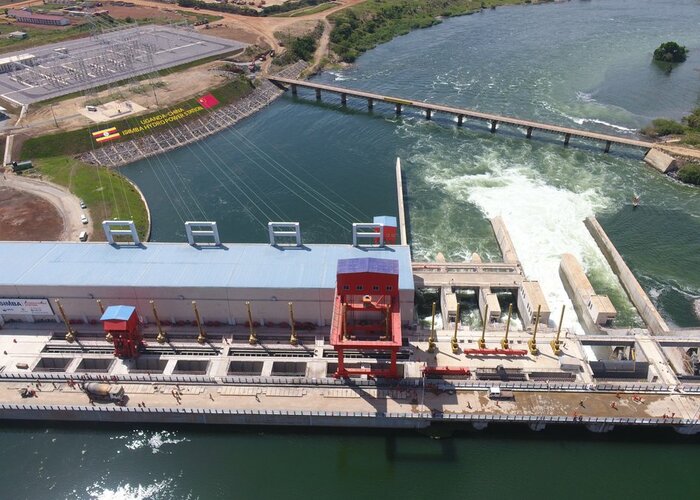
The move is expected to bridge the gap of electricity consumption and bring down the exorbitant power costs that continue to cause an outcry while keeping most consumers at bay.
According to Eng. Harrison Mutikanga, the UEGCL chief executive officer, the electricity to the national grid will be priced at $5cents (about sh185) drop from the current over $8cents (about sh297) offered by Bujagali hydropower project.
Banking on Isimba and Karuma, the President has on many occasion assured investors and the business community that the high electricity tariffs will soon go down.
"You do not have to worry about the electricity costs because we expect it to go down after completion of the many dams we are constructing," Museveni said, during the commissioning the new Simba Cement factory in Tororo district last year. Mutikanga adds that Isimba hydropower plant is a step towards achieving the 17,000MW target set by the President during the State-of-the- Nation address last year.
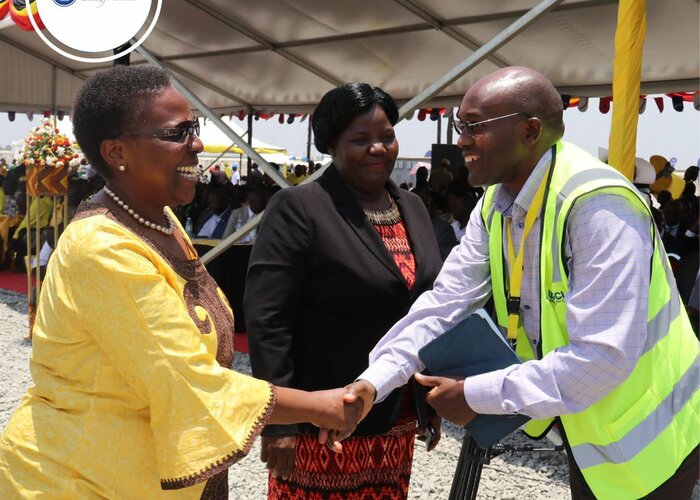
Energy minister Irene Muloni being received at the function Thursday morning
"Uganda's installed electricity generation capacity is a meager 955MW with a gross domestic product (GDP) per capita of about $615 (about sh2.2m). Wealthy countries have invested heavily in electricity infrastructure. For instance, South Africa, with a population of about 56 million people, has an installed generation capacity of 46,943MW with a per capita GDP of $6,268 (about sh23.2m) and per capita consumption of 4,198kWh.
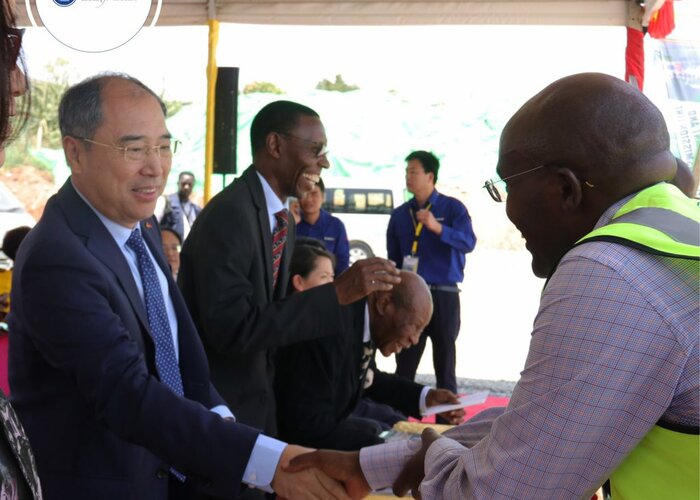
If Uganda is to sustain GDP growth, we need electricity and lots of it," Mutikanga says. It has taken the contractor 47 months to complete the hydro power dam with a delay of seven months. According to Mutikanga, UEGCL is ready and equipped with the necessary manpower to operate and maintain the Isimba power plant.
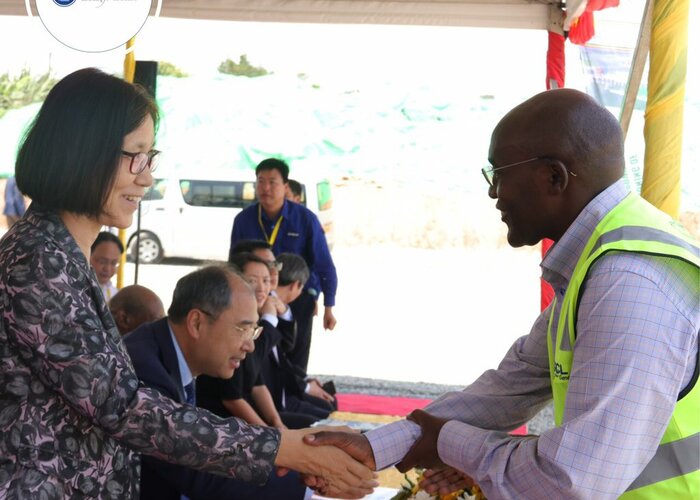
"We set out a plan to develop our operation and maintenance capacity hinged on two major pillars; recruitment of the core team and capacity building. And after two years of intense training, we are ready to efficiently run Isimba power plant," Mutikanga says.
Isimba to link Kayunga, Kamuli
For more than threeand- a-half years, Julia Nabukeera has been using the Mbulamuti ferry to cross River Nile to visit her siblings who live in Busaana, Kayunga district.
She has also been ferrying pineapples from which she is getting money she is using to build a four-roomed structure that will accommodate the retail shop she plans to open. The sh3b ferry commissioned by President Yoweri Museveni in 2013, is still the only link between Kayunga and Kamuli districts via River Nile.
According to the Ugandan National Roads Authority (UNRA), the ferry acts as a mobile road, connecting Kasana and Mbulamuti landing sites. On a daily basis, UNRA says the traffic averages 700 passengers and 65 vehicles. A dusty road snakes out of Mbulamuti, running 16km to join the Jinja-Kamuli road, an asphalt grade road commissioned about five years ago.
According to the Speaker of Parliament, Rebecca Kadaga, the 16km stretch is meant to get a paste of tarmac, to match with the Isimba power dam project, before stretching beyond Isimba to Kayunga town. An adjoining bridge connecting Kamuli and Kayunga is also being constructed to quicken mobility, trade and development in the two districts.
Located a few meters from the dam, the bridge is part of the Isimba project under component 2, whose completion is expected by December 2020. While touring the new power plant last week, Kadaga was assured by the contractor that the bridge would be built according to the specified standards.
"Last time, they wanted to commission it, but I declined, informing them that they could not commission it until the bridge was constructed. That was one-and-a-half years ago. I want an assurance that the bridge and the road are going to be done," Kadaga said.
According to Jonan Kizza, the Isimba hydropower project head of public and corporate affairs, the basic designs for the bridge have already been completed. He says the contractor, China Water and Electrical Company Limited, is now conducting geotechnical investigations prior to commencement of the detailed design and construction.
Details from Isimba also reveal that the bridge will be constructed in two spans; one connecting from Kayunga to Kuva Island and the other from Kuva Island to Mbulamuti on the Kamuli side. Kizza says upon completion, the bridge will provide a better means of transport between Kayunga and Kamuli.
"It will also provide employment opportunities to residents, both in Kayunga and Kamuli, as well as stirring up the growth of micro and small businesses along the river banks," he says. He adds that the cost of the bridge is embedded in the $567m (about sh2.1 trillion) Isimba dam project, funded on a loan from the Chinese government with counter funding from Uganda.
The Isimba hydroelectric power station is an 183.2MW project comprising a concrete gravity dam, a clay-core rock fill dam, a spillway, a power house, electro-mechanical equipment, switching stations and auxiliary power transmission works.
The project, considered the fourth biggest hydropower project in Uganda, is expected to generate hydroelectric power at 68 cents per kWh, the lowest in East Africa. Its breaking of the ground ceremony was conducted in October 2013 and, after approximately 64 months, the power dam comes online this Thursday.
We hope to generate 17,000MW by 2028, says UEGCL's Mutikanga
The 183MW Isimba Hydro Power Plant is being commissioned this Thursday. Owen Wagabaza asked Dr. Eng Harrison Mutikanga, the chief executive officer of Uganda Electricity Generation Company Limited (UEGCL), the company mandated to run the plant, about its readiness to operate the dam, among others issues. Below are the excerpts.
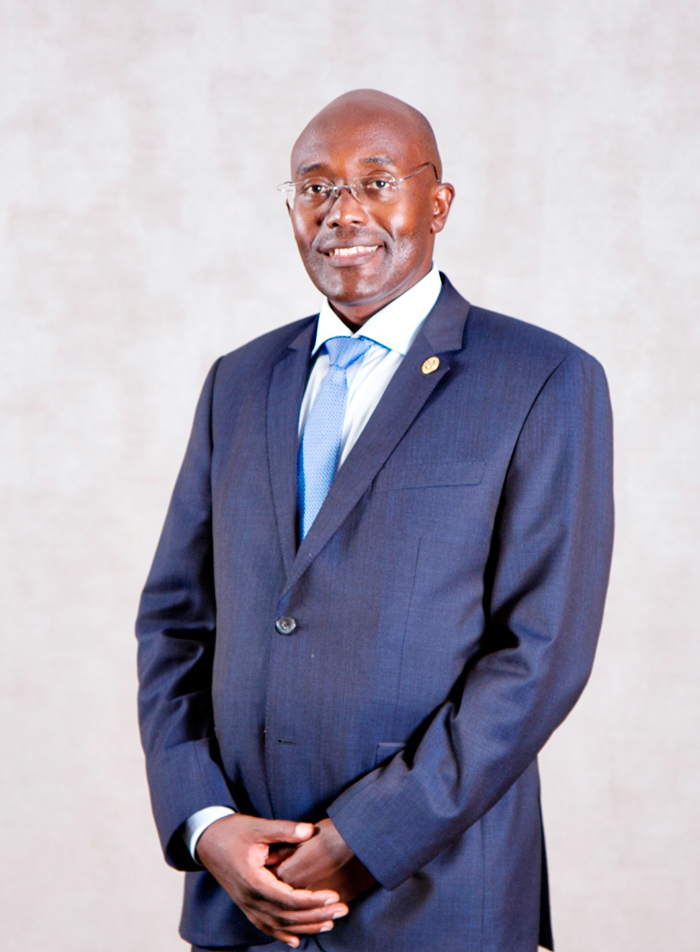
Eng. Harrison Mutikanga
How close are we to attaining the 17,000MW target by 2028 as set by the President?
On the side of UEGCL, we have already delivered the 183MW from Isimba towards that promise, but I also know that in January this year, the President commissioned a 20MW solar power plant in Kabulasoke, Gomba district. When you add the two, you get 203MW that have been added to the national grid in regard to the target.
How would you describe the progress so far?
The progress is slow. On average, we should be doing 1,700MW per year. We, therefore, have a lot of work to do.
What needs to be done then, to achieve that target?
For Uganda to realise an additional 17,000MW of installed generation capacity over the next decade, it will require close to $51b in new investments based on the average unit investment cost of $3m per MW of the ongoing and recently developed large hydropower projects in the country. The challenge for the Government will be how to mobilise the huge capital investments amid public debt ceiling constraints and requirements from other priority public sectors such as health and education.
The Government will certainly need support from development partners, foreign and domestic private investments, international financial institutions such as the World Bank, inter-country joint investments, expanding and integrating the regional electricity market and trade, and floating government infrastructure bonds.
Innovative ways of securing foreign finance such as securitisation of a portion of future oil revenues should be considered by the Government to obtain low-cost finance and circumvent the debt ceiling.
We could also allow UEGCL a return on investment, say for example (we are commissioning Isimba dam), if we allow a reasonable return on investments over the years, we can accumulate enough money that we could use to invest in new electricity generation infrastructure.
This is what our counterparts in Kenya are doing. The Energy Regulatory Commission (ERC) in Kenya has empowered KenGen, a government company similar to UEGCL, to execute infrastructure investment projects. KenGen posted a profit of $90m in 2017, according to that year's annual report. In the past 10 years, KenGen has executed investments worth $2.2b from internally generated cash fl ows and added over 700MW new capacity, bringing the total installed capacity to 1,631MW.
All this has been achieved while ensuring competitive tariffs within the region. KenGen's good financial health has enabled the company to list on the stock exchange, thus making it easy to mobilise infrastructure investment funds.
What are some of the challenges to attaining that target?
The challenge is the debt-ceiling limitations.
The Government now has a limit on how much they can borrow, after Karuma, Isimba and other infrastructural projects going on in the country. The other challenge is that the Government has already signed memoranda of understanding with potential investors for a cascade of hydropower plants along River Nile, with a total of 1,862MW (Ayago-840, Oriang-392, Kiba-330 and Uhuru-300).
These projects have been ring-fenced, but the investors are finding it hard to get the money. The Government has to find a way to partner with the private sector to develop these projects and the best way is to capitalise UEGCL or allow the company a return on investments.
This needs to be done quickly because if we develop all these projects on the River Nile, another 1,862MW would be added to the national grid.
But also, we need an energy mix so that we don't entirely depend on hydropower, but go into solar and explore the geothermal potential along the rift valley. That is being done under the department of geology in the energy ministry. Unfortunately, those people (Geology department) don't have targets like we do.
What we see as a priority may not be so to them. There is, therefore, need for internal reforms.
But do we need all this power, do we have the capacity? The current demand is just 500MW?
Electricity access in Uganda is estimated at 22%, implying that over 30 million Ugandans have no access to electricity.
With an annual average electricity consumption of 80 kWh per capita, this translates into suppressed demand of over 500MW. If this demand is unlocked through the new government Electricity Connection Policy (2018-2027), with an annual target of providing 300,000 free on-grid connections, it is likely that the whole of Karuma (600MW) could be exhausted by 2028.
In the past few months, the President and Cabinet have presided over breaking of the ground ceremonies and commissioning of several new factories. When all these factories are in full operation, they are likely to exhaust the Isimba 183MW.
This boom in factories has already created over 20,000 jobs. More job creation and the anticipated revenues from oil exports will enhance per capita income and with it per capita growth in electricity consumption. From the 2014 National Population Census data, Uganda's population will be about 53.3 million by 2028, assuming the average annual growth rate of 3.0%.
In the event that the National Development Plan (NDP II) goal of middle-income status by 2020 is achieved, the average per capita consumption in 2028 could be about 1,874 kWh (World Bank dataset for low-middle income). Allowing for 22% energy system losses and a capacity factor of 70%, Uganda will need not only 17,000MW, but 20,505MW in installed generation capacity by 2028.
You are talking of 300,000 new connections every year, but the cost price of electricity is too high. What are you doing to lower it?
We are working efficiently. We are taking over Isimba dam and to keep the tariff down, we have to operate efficiently.
The Government has also made a deliberate strategy not to leave public infrastructure investments in the hands of the private sector. The Government borrowed money for Karuma and Isimba at a low interest rate — what we call concessional rates. That is why the cost of electricity from Karuma and Isimba is much lower than what we have at Bujagali. Karuma is to be at 5 cents and Isimba at 4.1 cents and this is cheap.
We are also working with our sister agencies in distribution and rural electrification to increase demand. The more demand you get, the less the tariff. The Natural Resources Committee of Parliament recently visited Jinja and recommended the termination of Eskom due to poor performance.
Eskom is earning a return on investment of 12%. If those plants came back to UEGCL and we earned a return on investment of say 5%, instead of 12%, this would result into a reduction of tariff. All these are efforts being made by UEGCL to bring down the cost of electricity.
UEGCL will be taking over the operation and maintenance of Isimba hydro power plant. How equipped are you in regard to running the facility?
We have spent the last two years recruiting and training young engineers and technicians.
We got support from development partners and we were able to place the young engineers in plants in China, France, Laos and Zambia. They have also been participating in factory acceptance tests, in the commissioning and testing of the equipment and are basically the ones running the plant. In that aspect, therefore, we are good to go.
How Isimba's Kaplan turbines work
By Eseri Atholere
The Kaplan turbine is one of the most commonly used turbines in hydropower infrastructure around the globe. The Kaplan turbine was originally developed by Viktor Kaplan, an Austrian engineer, towards the beginning of the 20th century.
Kaplan developed the Kaplan turbine by further improving the basic principles of the Francis Turbine. A Francis turbine is a mixed flow (with both radial and axial flows) turbine which bears fixed blades. To develop the Kaplan turbine, Kaplan combined automatically adjustable propeller blades with automatically adjustable wicket gates.
This gave birth to the Kaplan turbine with a more efficient production of power in considerably lower head application scenarios which were not possible with the Francis turbine.
A Kaplan turbine is a reaction-type turbine in which the water pressure decreases as it passes from the inlet into the blade wheel through to the outlet. Over time, various configurations of the Kaplan turbine have been developed so as to make it more efficient and also give it a wider operational head range.

Typical Kaplan turbine system configurations include the fixed blade (fixed pitch) propeller in combination with wicket gates, moveable blade (variable pitch) propeller without wicket gates and the moveable blade (variable pitch) propeller in combination with wicket gates.
In the double-regulated turbine systems (movable blade propeller in combination with The Kaplan turbine wicket gates), the runner blade position (pitch) is harmonised to wicket gate positions to optimize the turbine operation to the actual water flow rate through wicket gates.
This characteristic makes the double regulated turbine most suitable for large flow and low head situations. Its efficiency is between 80% and 95%. The head experienced from the Kaplan turbine ranges anywhere from 1.5 meters to over 50 metres.
The turbine, however, usually operates most efficiently between heads of 1.5 meters and 20 meters. Over 20 meters, it is most likely that the efficiency of the turbine will start to decrease. Kaplan turbines can be installed in vertical, horizontal or inclined position, depending on the input flow and drive mechanism orientation.
UEGCL's Isimba dam and the NalubaaleKiira complex are all installed with the vertical oriented Kaplan turbine. The vertical orientated Kaplan turbines allow for runner diameters up to 10 meters. The efficiency of these Kaplan turbines can be increased by adjusting the inlet angle, the exit angles, the radius of the turbine and the blade pitch angle. All of these factors are unique based on the flow rate of each specific location and flow scenario.
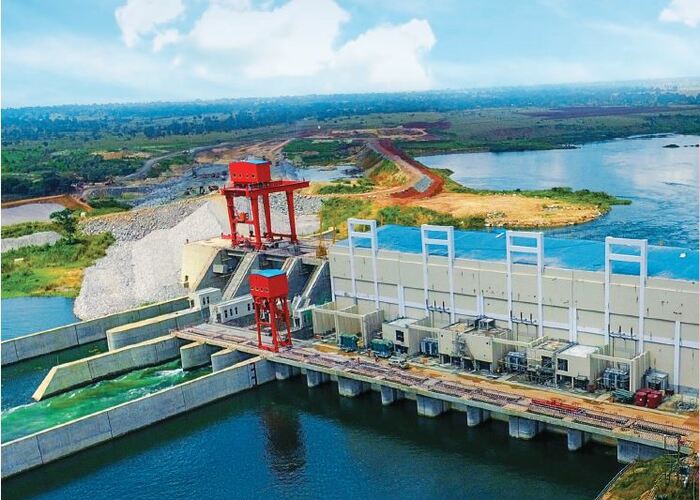
Kaplan turbines are effective in nearly any region around the world because they do not require much head. As long as there is relatively high hydraulic flow, a Kaplan turbine may be put into place.
Kaplan turbines are suitable for operation when water energy is available in the low head (1.5m - 25m) and high flow (70 - 800m3/s). This necessitates the need for water to be stored in a large reservoir in a relatively shallow altitude.
In a Kaplan turbine, flow is entered through a spiral casing. The decreasing cross-sectional area of the spiral casing leads the flow to enter the central portion almost at uniform velocity throughout the perimeter. The water flows to the runner after passing by the open wicket gates and finally, it leaves through a draft tube.
Cross section of a runner blade has a curved shape. When water flows over it, it will induce a lift force due to airfoil effect. The tangential component of the lift force will make the runner rotate. This rotation will be transferred to the generator rotor by means of a shaft which is a rigid link that connects the turbine hub to the rotor.
The writer is a mechanical Engineer with Uganda Electricity Generation Company Limited.
Mitigating environmental impact of Isimba plant
By Owen Wagabaza
Following the Government's breaking of the ground ceremony in October 2013 for the construction of the 183MW Isimba Hydro Power Dam along River Nile in Kayunga district, environment and tourism activists came out in numbers to oppose the dam construction.
The activists feared for the worst, saying the dam construction was to be at the cost of tourism and environmental protection. According to the social impact assessment (SIA), the dam was to negatively affect tourism development activities at Kalagala falls and degrade the present natural ecosystems of Mabira Central Forest Reserve, Kalagala Central Forest Reserve and Nile Bank Forest Reserve.
The project, it was said would affect the operation of adventure tourism, affecting not only primary businesses, but also secondary and tertiary businesses, according to the SIA. More to that, it was to destroy a significant breeding ground for Uganda's national bird — the endangered grey crested crane and numerous other species of birds, animals and plant species.
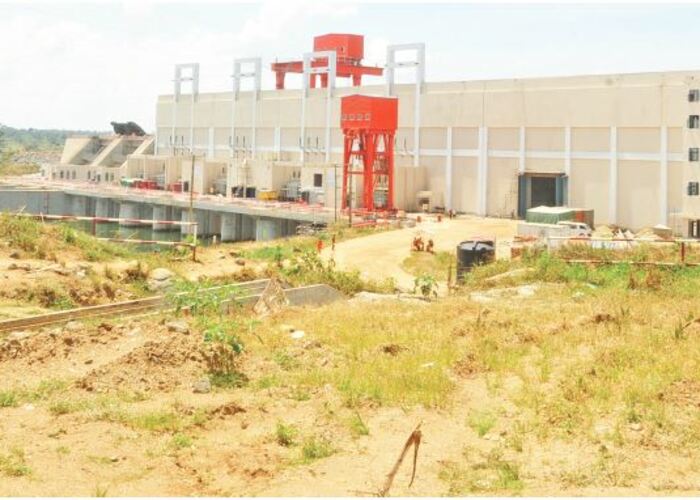
The power house at Isimba Hydro Power Dam project before completion. The construction of dams comes along with many environmental threats
The dam was also in contravention of the agreement that World Bank signed with the Government of Uganda in 2007 with the objective of conserving River Nile. According to Peter Sseruyange, an environment activist, the establishment of a dam in the area will translate into the establishment and growth of industries along the Nile. As a result, River Nile and the environment surrounding it will be degraded and polluted, thereby frustrating the conservation of the area.
Necessary evil Edgar Kansiime, an environment officer with Uganda Electricity Generation Company Limited (UEGCL), concurs that indeed, hydropower facilities can have a large environmental impact by changing the environment and affecting land use, homes and natural habitats in the dam area.
"Most hydroelectric power plants have a dam and a reservoir. These structures may obstruct fish migration and affect their populations. Reservoirs may also cover people's homes, important natural areas, agricultural land and archaeological sites," Kansiime says.
"However, be it known that humankind has flourished, largely due to the ability to harness far more energy than we are physically able to generate. Unfortunately, most, if not all of these efforts, have had unintended consequences," Kansiime explains.
Moses Bagyenda, a development analyst, says despite the effects the dam may have on the environment, Isimba dam is equally good news for Uganda because of the terms and conditions that come with it. "For starters, Isimba was financed using a soft loan from China's Exim Bank, repayable in over 10 years.
The dam will also boost the capacity of electricity generated in the country from 955MW to 1138MW," Bagyenda says. "With enough power, Uganda will attract industrialists, who will in turn provide jobs both directly and indirectly stimulating production, and the tax base, among others.
We need as many hydro-power dams as possible if we are to become an industrialised nation," he adds.
Mitigation process According to Kansiime, Uganda can still generate the power it needs to achieve her economic development goals and at the same time protect its natural environment.
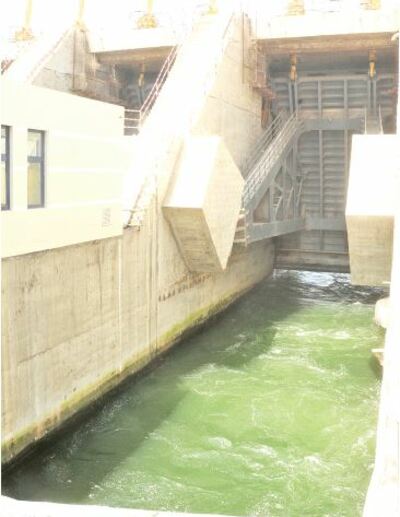
"This can be achieved through the planning of proper environment impact assessment studies and biodiversity assessment and monitoring activities prior to the onset of such huge hydropower projects," Kansiime says.
He adds that the essence of these studies is globally acclaimed as foresight into some of the impacts the project might have on the natural environment and formulating standard mitigation activities to counter these impacts. Doreen Abamurungi, an environment officer attached to Isimba, adds that these plans should not only counter the impacts at the project's level, but also consider those impacts during operation and maintenance of hydropower stations.
"In fact, operating a hydroelectric power plant may also change the water temperature and the river's flow. These changes may harm native plants and animals in the river and on land,"Abamurungi says. UEGCL has come up with programmes such as the Community Development Action plan and continuous community sensitisation, specifically targeting the surrounding communities and those directly impacted by the onset of the project in their area.
"Community sensitisation about the pros of having such huge projects in their area, for example, social and economic boost through jobs and improved infrastructure, can aid to pamper some of the backlashes from the local communities," Kansiime says.
Abamurungi adds that restoration efforts offset and regeneration of vegetation through planting trees in the project area, especially along the river banks and reservoir boundaries, are some of the mitigating measures being undertaken by UEGCL. "We have also embarked on the conservation of the ecosystem by maintaining water flows capable of maintaining the river," Abamurungi says.
UEGCL is also implementing measures to prevent invasion of foreign species throughout the duration of projects and this included the construction period. They have also come up with follow-up studies after the measures are taken and evaluation of their effectiveness among others.
"It is, therefore, important to ensure that energy is extracted, converted and utilised sustainably. And a hydropower project is possible, but requires proper planning and careful system design to manage the challenges," Abamurungi says.
Chaglla project
The Chaglla project on the Huallaga River in Peru was and still remains an example of thorough environmental and social risk assessment in modern times. A highly-engaged stakeholder process resulted in assessments on fish and ecology, water quality modelling, downstream flow modelling, a resettlement action plan and analysis of the project's carbon footprint.
Additional outcomes included the establishment of a new social services and agricultural services extension centre, 800 local people trained to work on the project, a recycling centre set up, the discovery of several new species and the establishment of an "important bird area" in the region, which will help protect the bio-diverse forest.
Isimba dam symbolizes China-Uganda friendship
President Yoweri Museveni on Thursday commissioned the Isimba Hydropower plant in Kayunga district. New Vision's Owen Wagabaza talked to Jiang Shougou, the vice-president of China International Water and Electric Corp., the EPC Contractors of the 183MW Isimba plant on what the successful completion of the project. Below are the excerpts
Tell us about China International Water and Electric Corp
China International Water & Electric Corporation (abbreviated CWE) is a wholly-owned subsidiary of China Three Gorges Corporation (CTG). It is the first state-owned enterprise of the Chinese hydropower industry to take part in international economic cooperation initiatives.
Nowadays, CWE has been acknowledged as a famous brand in the fields of international contracting and small-to-medium energy and power investment. Many projects undertaken or developed by CWE have become world-renowned water and hydropower constructions, among which there are dams symbolizing friendships between nations, hydropower stations hailed local "Three Gorges" in project-host countries, and large-scale hydraulic complexes and other infrastructure works considered beacons of international cooperation.
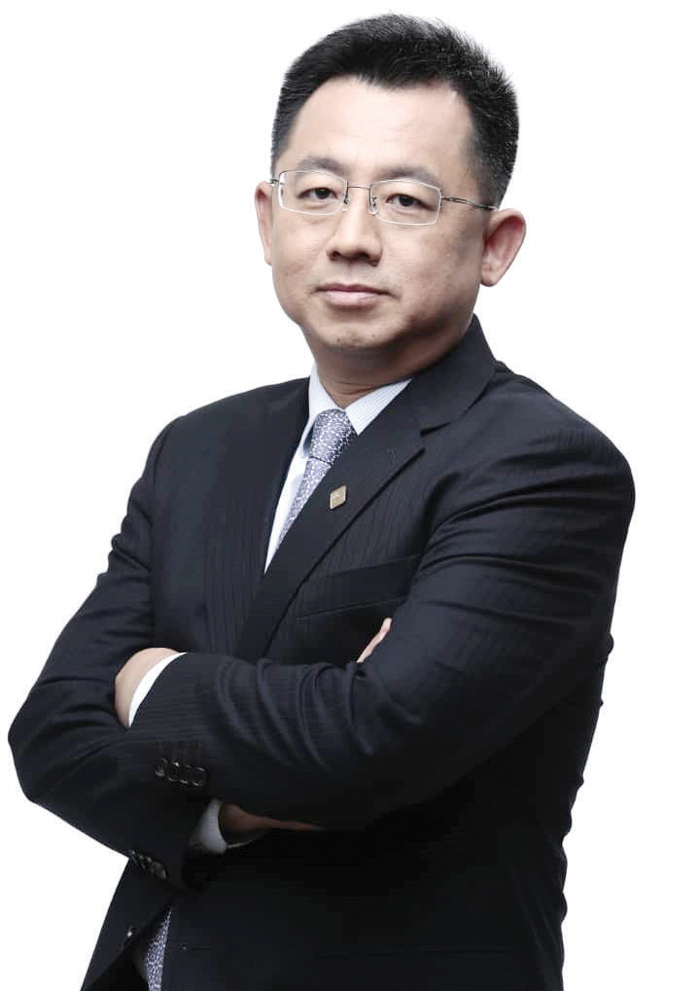
Having undertaken projects in over 80 countries and regions in Asia, Africa, Europe, and America and ran business units in 31 countries and regions, CWE has made prominent achievements in its main business of water and hydropower.
Over the past decade, CWE has successfully completed the Merowe Dam Project in the Sudan, the Kaleta Hydroelectric Project in Guinea, the Nam Lik 1-2 Hydropower Station and the Nam Ngiep 2 Hydropower Station in Laos, the Kozjak Hydroelectric Project in Macedonia, the Moinak Hydropower Project in Kazakhstan, the Dam Complex of Upper Atbara Project in the Sudan, as well as many other hydropower and infrastructure projects.
CWE has been ranked an ENR TOP 250 International Contractor for 27 consecutive years, and an ENR TOP 225 International Design Firm for 16 consecutive years. In the future, by adhering to the idea of healthy sustainable development, CWE is to build itself into an international clean energy construction and investment company.
It aims to integrate "Investment-Construction-Operation- Management", assume social responsibilities, focus on localization, promote the economic development of project-host countries, benefit local peoples, and enhance the vitality of global clean energy industry with more projects of outstanding quality, safety, technology, and effective measures for environmental protection.
What does the successful completion of Isimba dam mean to CWE?
We are proud that we have successfully completed Isimba dam and that the work is of high quality. This has been recognised by the Ministry of Energy, Uganda Electricity Generation Company Limited and the Owner's Engineers, Artelia Eau and KKATT Consult Limited concur that some of the best works in hydro-power dam construction.
The project was financed by China and Uganda and this makes it one of the many symbols of China-Uganda friendship. Isimba dam completion means a lot to us and I am very proud of the team that worked day and night to see it through.
What are some of the challenges that you encountered during the construction of the dam?
As it happens with any big project, there were quite a number of challenges, but together with the client and consultant, we were able to overcome them. One of them was the installation of the turbine generators, with a diameter of 11.5m; it proved quite a challenge to install these turbines.
This was because turbines of such sizes are not common. We had to bring in a professional team from our sister company who worked on the Three Gorges dam to help and they did it successfully. But there were also challenges such as language barrier, but we finally overcame them and understood each other and everyone is now happy.
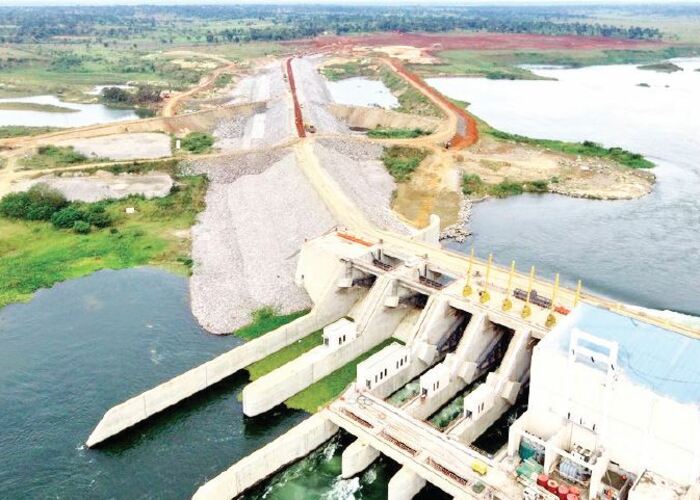
What do you have to say about the relationship between Uganda and China?
Uganda is a strategic partner. As you may know, China has been supporting a number of infrastructural developments in Uganda because infrastructure, especially energy, is the base of economic development for any country.
With energy and good roads, you attract investments that result into the development of the entire country through taxes and availing jobs both directly and indirectly. The living standards also improve for the better, as well as the purchasing power.
That aside, Uganda spends a lot of foreign currency importing goods, but with industries manufacturing goods, Uganda will not only save on the foreign currency spent, but it will earn through exporting goods to other countries. Well aware of that, the Chinese government has not hesitated to support the Ugandan government in pursuing her goal of becoming a developed country.
We are, therefore, both politically and economically strategic partners.
What next for CWE in Uganda?
I am reliably informed that going by the developments going on in the country, even with the addition of Isimba and Karuma to the national grid, in a few years less than expectation, the demand for power will overtake the supply.
We are, therefore, looking at making investments using the BOOT model. In the BOOT model, you build, own, operate and transfer.
We, therefore, intend to invest in power sector by building hydropower dams using our own money and investment our money through competitive tariffs. This will also relieve the government from getting loans to invest in power, and the beauty about it is that we transfer 100% ownership to the government after 25 years.
We have done that in a number of countries, notably Brazil and Chile. In Laos, we have three hydropower stations owned by CWE. We are also working in Nepal and many other countries.
What role does UETCL play?
By Vision Reporter
As Uganda celebrates the commissioning of Isimba power project today, the project is adding up to 183 MW to the current 984MW, taking Uganda's installed generation capacity to 1167MW.
The Isimba project was developed at a total cost of $567.7m (about sh2.1 trillion). Of this, $482.5m (about sh1.785 trillion), which is 85% of the funding, was provided through a loan from the EXIM Bank of China, while the Government provided a counter funding of $85m (about sh314.5b).
The project was implemented by two government agencies, Uganda Electricity Generation Company Limited (UEGCL) and Uganda Electricity Transmission Company Limited (UETCL). It was contracted to the China International Water and Electric Corporation and supervised by Artelia EAU and Environment.
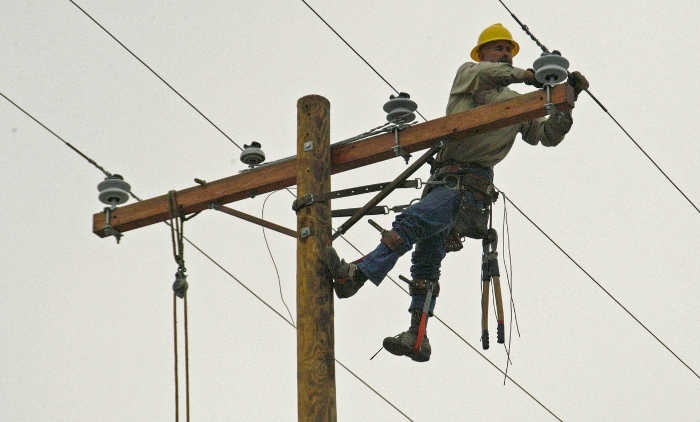
While many may be familiar with UEGCL's role at the project due to its mandate of generating electricity in the country, few could be aware of UETCL's role. The 1999, the Electricity Act that unbundled the former Uganda Electricity Board gave way for the formation of three successive companies to handle generation, transmission and distribution of electricity in the country. It is the Act that established UETCL as the sole buyer of all generated electricity at wholesale price for resale to different distribution companies.
Contextualising it in a retail business setting, generation plants, such as Isimba and Nalubaale and Bujagali, among others, are the manufacturers of electricity. They then sell power to UETCL, the wholesaler in the electricity distribution chain that transports the utility to different substations (load centres) in bulk. UETCL then sells the electricity to distribution companies such as Umeme and UEDCL that sell it to the final consumers.
The agency operates the country's transmission system network commonly known as the grid. Once the electricity is generated from a plant, it is transmitted to a high voltage switch yard (sub-station) which is built at the project site. It is from this switch yard that electricity is transmitted through a high voltage line to different places.
Power from Isimba shall be transmitted through the Isimba-Bujagali interconnection project, a 42km-long, 132kV double circuit steel tower power transmission line from the switch yard at Isimba dam to the existing switch yard and Bujagali dam. The line is expected to enhance stability and reliability in electricity supply.
Strategic plan This project shall, among other benefits, provide electric power to meet the energy needs for the Uganda population for socioeconomic development. In 2015, the company launched its five-year corporate business plan through which it is seeking phase out old lines and construct double the then transmission line coverage from 1,630km.
Currently, UETCL intends to double its existing national grid base from the current 2,318km of high voltage transmission lines to over 3,000km. High voltage lines are those with capacities of 132kV, 220kV and 400kV. Currently, the company is developing three projects under the Karuma interconnection project.
These shall be used to evacuate power from the 600MW Karuma project, which is under development in Kiryandongo district in northern Uganda. These are Karuma- Kawanda and Karuma- Olwiyo, both 400kV capacity lines, as well as the Karuma-Lira 132kV lines. Other lines are Bujagali- Tororo-Lessos, Mbarara- Mirama, Tororo-Opuyo- Lira, Opuyo-Moroto and Nebbi-Gulu-Arua.
Once completed, the projects shall enable the company to foster reliability in supply and aid interconnection with neighbouring countries. The Isimba project aims to support government programmes and reinforce capacity to meet the increasing demand.